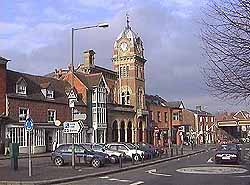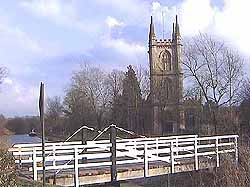
RBH Home
Maps & Travels
Articles
Legends
Towns & Villages
Castles & Houses
Churches
Biographies
Gentry
Family History
Odds & Ends
Mail David
Hungerford
Last Stop in the West
 Hungerford,
though in Berkshire, has the layout of a typical Hampshire market town: a
great wide High Street with quaint little shops lining both sides as far
as the eye can see. A picturesque arcaded town hall once stood in the
middle of the road, but the Victorians pulled it down in favour of a new
version, the very imposing red brick building with Byzantine style tower
that we see today. There are two good car parks, well sign posted from
here. Hungerford is the antiques capital of Berkshire and almost every
other shop seems to have a bygone age for sale. The 'Hungerford Arcade' is
a particularly fascinating place to mooch round and you may even find
yourself a bargain. Individual dealers each have their own small kiosks
here, all undercover and centrally controlled. Almost adjoining is the
'Courtyard': a delightful hidden quadrangle with shops and eateries in
ancient overhangs.
Hungerford,
though in Berkshire, has the layout of a typical Hampshire market town: a
great wide High Street with quaint little shops lining both sides as far
as the eye can see. A picturesque arcaded town hall once stood in the
middle of the road, but the Victorians pulled it down in favour of a new
version, the very imposing red brick building with Byzantine style tower
that we see today. There are two good car parks, well sign posted from
here. Hungerford is the antiques capital of Berkshire and almost every
other shop seems to have a bygone age for sale. The 'Hungerford Arcade' is
a particularly fascinating place to mooch round and you may even find
yourself a bargain. Individual dealers each have their own small kiosks
here, all undercover and centrally controlled. Almost adjoining is the
'Courtyard': a delightful hidden quadrangle with shops and eateries in
ancient overhangs.
The town is well-known for its large number of pubs and the Three Swans Hotel, with its huge bow windows, is an excellent place to sit and watch town-life go by. There are more watering holes as you move towards Bridge Street. Note the delightful Wysteria-covered 'Bridge House' with its Regency upper floor access point, as you pass. The 'John of Gaunt' Inn is named after Hungerford's local hero. This 14th century son of King Edward III was the Lord of the Manor who handed over the jealously guarded fishing rights on the River Kennet to the townsfolk. His patronage is celebrated with the annual 'Hocktide' festivities. On the second Tuesday after Easter, the Hocktide Court is called in the town hall while two "Tutti-Men" collect fishing right fines from the residents of the High Street. The "Orange-Man" gives out oranges to the ladies in return for a kiss!
 The
River Kennet flows through Hungerford at Eddington, a pretty hamlet now
merged into the town on its Northern Edge. Follow the road up the hill
towards the M4 and the keen-eyed may spot two memorial crosses to
policemen murdered by poachers in the late 19th century. The River Dun
also bisects the town, running behind the Bear Inn in Charnham Street.
This huge coaching inn is, perhaps, the most historic building in the
town. Dating back to the 15th century, William of Orange was a resident
for several nights during the Glorious Revolution of 1688 and was here
offered the Crown of England.
The
River Kennet flows through Hungerford at Eddington, a pretty hamlet now
merged into the town on its Northern Edge. Follow the road up the hill
towards the M4 and the keen-eyed may spot two memorial crosses to
policemen murdered by poachers in the late 19th century. The River Dun
also bisects the town, running behind the Bear Inn in Charnham Street.
This huge coaching inn is, perhaps, the most historic building in the
town. Dating back to the 15th century, William of Orange was a resident
for several nights during the Glorious Revolution of 1688 and was here
offered the Crown of England.
Despite these two rivers, the main waterway in Hungerford is the Kennet and Avon Canal, opened in 1799. Colourful barge trips are a regular feature of the old Wharf and there are always ducks and swans to feed. The lock was restored in 1974 and there are pleasant canal-side walks down towards the parish church. St. Lawrence's is an early example of Gothic revival architecture, rebuilt when the previous structure almost collapsed in 1814. It is usually open to the public and houses some beautiful stained glass. There is a rare 'clapper' stile in the churchyard.
Hungerford Common lies at the end of Park Street, not far from the Railway Station. It is a surprising area of open parkland (200 acres) on the edge of the town, still used for grazing cattle as it has been for centuries. Hence the cattle grid and 'Down Gate' to stop them wandering into town! It is a great place for a picnic, to fly a kite or walk the dog and is occasionally used for shows and circuses.
Next: Wantage
